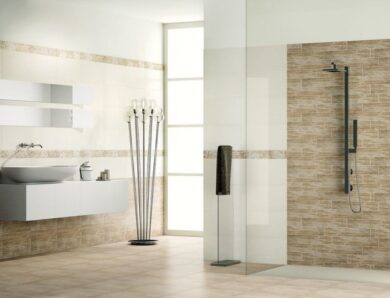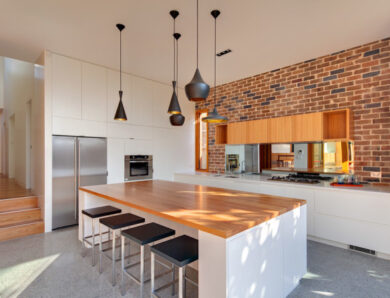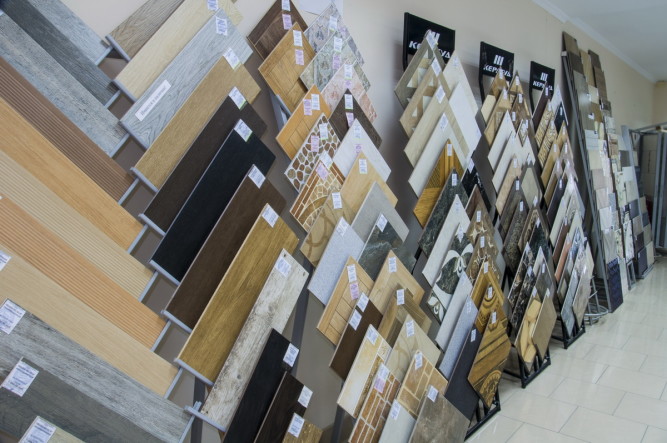Kitchen countertop made of tiles with his own hands: how to make
To create an original kitchen interior, use a tile for a table-top and an apron. She is able to transform a wall. One of the advantages is the ability to do the work with your hands.
The original solution is decorative
Role
The kitchen countertop is the main place, where you cook, it is constantly exposed to various influences: mechanical, chemical, temperature, etc.. d. It is important to provide such material, which will withstand endless cleaning, hit the dishes, water drops, fat and other substances. Some housewives prefer to cut food directly on the work surface, without the use of a cutting board, so take care of it, so that no scratches from the knife remain on it.
All this must be taken into account, if you decide to make a table top from tiles with your own hands. However, do not forget, that in addition to functional properties, the work surface has a decorative purpose. Thanks to her, the kitchen gets a finished look. With the help of the desktop, you can completely change the style of the headset.
It is important to follow the rules of combining the material, its color and texture.
Interior solution in the kitchen
Pros and cons
Tiled countertop has a number of advantages and disadvantages.
Dignity:
- practicality;
- aesthetics;
- the ability to create a pattern and combine elements of different shades on one surface;
- relatively low cost;
- absence of harmful impurities;
- quick installation;
- when selecting quality material will last a long time;
- good tile is not afraid of moisture, exposure to high temperatures and differences in these indicators;
- a damaged item can be replaced with a new one.
That the table-top did not go cracks, the tile for it must be of high quality
The disadvantages include the following indicators:
- point blows will damage the surface;
- high probability of chipping at the edges;
- dirt is clogged in the seams, which reduces the rate of hygiene;
- abrasive materials must not be used during cleaning;
- over time and with improper care, the aesthetic characteristics of the surface are reduced.
How to choose the material
Service life and decorative performance depend on the tile. What you should pay attention to in the first place? Of course, these are the technical characteristics of the tile. For operating conditions in the kitchen as a coating for the work surface, it must be impact resistant, do not be afraid of temperature changes, exposure to alkalis, acids and various kinds of pollution, minimally absorb moisture.
If you choose a specific material, it is better to stop on porcelain tile. It has high strength and unique wear resistance properties. A simple tile will last less.
exept this, pay attention to the type of surface. For the kitchen it is better to choose smooth semi-matte materials. Firstly, dirt will not clog the pores, and scratches are noticeable, secondly, such a tile looks attractive.
Choose the color of the tile, combined with furniture and the surrounding interior. The standard solution is to buy the same tiles for the table top and apron.
AND, finally, pay attention to the size of the elements and their shape. It can be a large square, rectangular ceramic tile or small mosaic. Big details are good topics, that the number of seams is minimized. Small samples look perfect in a small kitchen. The traditional solution will be 15x15 squares. Choose a rectangular frieze for the edge.
Preparation of the basis
Before you make a tabletop of ceramic tiles, it is necessary to level a surface. To do this, use dense plywood or OSB. To ensure the desired thickness, several sheets are glued together.
An important condition - waterproofing. The material is treated with antiseptic and water-repellent impregnation.
After complete drying, on top of the last layer it is recommended to make small notches and fix the mesh for plaster.
The tile fits perfectly on the surface
To fit the sheets to the desired size and shape use a jigsaw. At the edges make small allowances, but keep in mind, that after facing to add some more centimeters. It is best to fasten the base with screws.
Another nuance: the weight of such a tabletop in the finished version is considerable, therefore we strengthen furniture. Add perimeter legs or support strips.
Facing
Next we will understand, how and in what sequence to lay out a tile a table-top.
Step-by-step instructions:
- Make a cement mortar, set beacons, strengthen the ends with metal profiles.
- Apply the mixture to the surface with a spatula. Leave to dry for a day or two.
- Make a mark on the prepared perfectly equal basis, which you will focus on in the process of laying tiles.
- Dilute the glue. Lay several control pieces according to the markup.
- Apply a small portion to the base and level with a notched trowel. Start laying the tile from the far corner.
- If you need to trim the item, make a small mark on the tile and use a Bulgarian or tile cutter.
- The last stage - finishing of an end face. It can be lined with the same tile, as well as a horizontal surface or a specially purchased frieze.
When performing work, pay attention to the end
Final finishing
After the kitchen countertop dries, take care of the seams. Even if the laying was done butt, it is still necessary to process the gaps, so that water and dirt do not penetrate into them. Usually use tile grout. It is better to choose it in the color of the coating, to create a sense of surface integrity. Apply with a small rubber spatula.
Epoxy resin can be used to protect against moisture penetration. It also prevents the growth of bacteria.
After processing, remove residual solution, mash and rub the tile to shine.
Care and maintenance boards
That the table-top from a tile served as long as possible and at the same time kept original look, take care of it properly.
Recommendations:
- wipe with a soft sponge, so that no scratches remain;
- prefer gels, rather than powders;
- use glass spray to care for glossy tiles;
- clean the seams regularly.
To keep the tabletop intact for longer, use a board to process the products, put the pan on a stand. Try not to hit the tile too much, especially at the edges.



